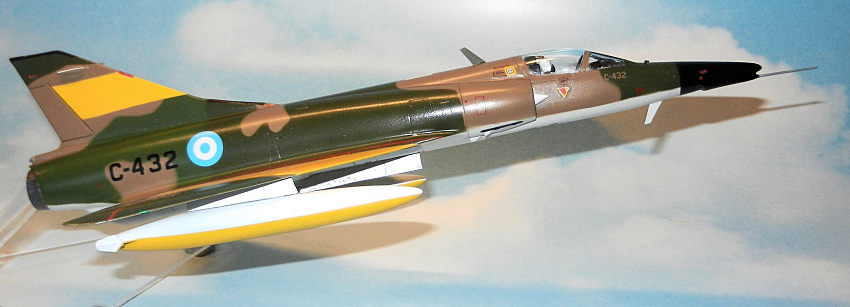
| KIT #: | P-14 |
| PRICE: | $30.00 (CN) |
| DECALS: | Several options |
| REVIEWER: | Pablo Calcaterra |
| NOTES: | Converted from Mirage IIIR |

| HISTORY |
Early on May 1st, BAM (Military Air Base) Puerto Argentino/Port Stanley Airport was hit by bombs dropped by a RAF Vulcan and several low flying Harriers. The runway was hit by a bomb but continued operational for the rest of the war while infrastructure and parked planes received varying degrees of damage.
The FAA answered with several air patrols to try to intercept the SHARs and gain full air superiority. At 9:40, the Commander of the Task Force asked for the surrender of the Argentine garrison. When this request was emphatically rejected the detection of movement of helicopters and small ships around Puerto Argentino/Stanley made believe the defenders that a landing operation was being carried out. Thus the FAA sent strike combos to counteract the RN activities (these missions included three A-4C CAPs, armed with Shafrir missiles (https://modelingmadness.com/review/mod/us/cala4c.htm), to target the helos)
At 14:25 three RN warships started shelling the island. These were HMS Arrow, HMS Alacrity and HMS Glamorgan. As a consequence several missions were sent to attack them covered by Mirage IIIEA/Dagger CAPS. Among all the planes that took part in this air strike, we will center our attention on TORNO flight.
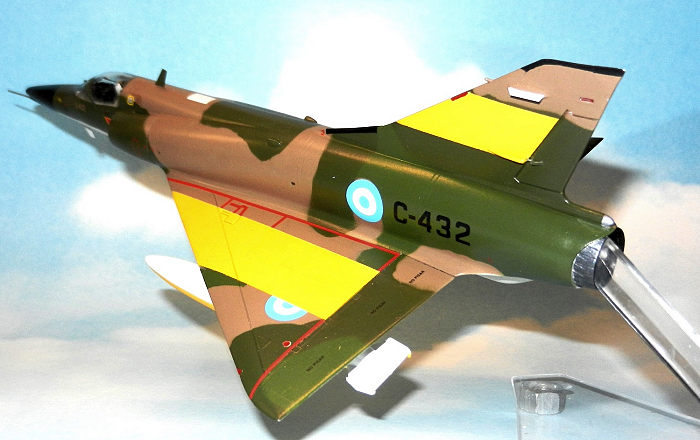 TORNO:
TORNO:
Three Daggers armed with 2 x 250 kg bombs in stations 2 and 5 (located under the posterior part of the fuselage) and 3 x 1,300 lts fuel tanks (stations 2, 4 and 6), which gave them scarcely 2 minutes flying time over the area of operations at high speed and ultra low height. Flown by Captain Dimeglio in C-432, Lieutenant Aguirre Faget in C-412 and 1st Lieutenant Román in C-407. All these planes were stationed in San Julián, and were part of the 2nd Moveable Squadron nicknamed “La Marinette”
TORNO, after taking to the air at 14:45, would descend to sea level 200 kilometers away from the islands to avoid radar detection. But when approaching the Sebaldes/Jason Islands, the air controller at Puerto Argentino warned them about the presence of a Harrier CAP that was heading in their direction. Therefore, using their airbrakes they dropped like stones to sea level until they were lost from the British screens. According to the orders they had received in Orden Fragmentaria 1105, the vessels were shelling Puerto Argentino/Stanley. Skimming the waters, they flew past the northern mouth of Estrecho de San Carlos/Falkland Sound and suddenly TORNO 2 saw a Harrier climbing into the clouds. Dimeglio decided to continue with their mission once alerted by his wingman. This SHAR had just fought against the Mirage IIIEAs of DARDO section (https://modelingmadness.com/review/mod/fr/calm3e.htm). When they reached Corrientes Point/Cape Carysfort the Daggers turned South, searching for their targets. The sea was calm and the ceiling was 500/1,000 feet.
Another pilot that gave his life and distracted another British CAP was 1st Lieutenant Ardiles who was shot down flying alone against the SHARs. At a very high cost these air combats allowed the TORNOS to approach their targets unchallenged. To their disappointment the enemy ships were nowhere to be seen within Bahía de la Anunciación. A quick glance to his fuel gauges told Capt. Dimeglio that they could still fly on some minutes to the South before returning to their bases in the mainland. The planes were flying in line abreast and 150 feet away from each other.
At 16:35 hs and flying 50 feet above the water Aguire Faget saw in the direction of the airbase (to his right) the tracers being fired at the approaching Mirage IIIEA. A few moments later TORNO 3 (Roman) saw some explosions on the water and in the air ahead which reminded him of fireworks. He realized that those were the British guns firing against the Argentine positions. He informed his sighting to Dimeglio who after finding the enemy targets ordered his wingmen to attack the ship ahead of each one. The naval formation was milling in a circle calmly shelling the Argentines from a position approximately 12 miles SE of BAM Malvinas (Stanley Airport). Nine kilometers to the North, the Daggers were closing in on their targets...the approach would take them 40 seconds. When faced by the planes, the destroyer was at the left (target for Aguirre Faget), one Class 21 frigate at the center (target for Dimeglio), and the other one at the right (target for Román).
Flying at no more than 10 feet above the water, the Daggers accelerated and approached the ships. Dimeglio attacked the ship he had assigned to Aguirre Faget because it was closer, presented an easier target and reduced the time exposed to AA fire.
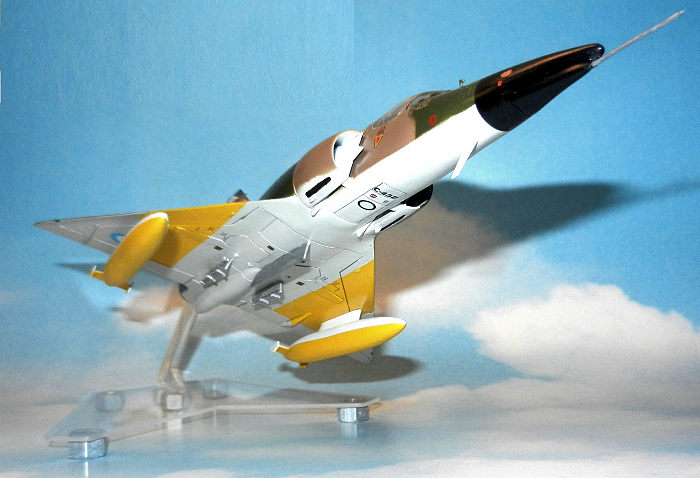 When they were close to the ships the pilots, except TORNO 3 who wanted to
mask his approach as much as possible, started firing their guns. TORNO 1 and 2
attacked the destroyer from the stern. After dropping his bombs on Aguirre
Faget’s ship, Dimeglio jumped over it, inverted his plane and put his wings
perpendicular to the sea. Flying this way he passed between some antennas then
turned right and found that he was facing his originally assigned target. He
shot the last rounds he had against it and flew as close as he could to the ship
attacked by Román. Eventually, he was over land and after some miles, he climbed
to the clouds.
When they were close to the ships the pilots, except TORNO 3 who wanted to
mask his approach as much as possible, started firing their guns. TORNO 1 and 2
attacked the destroyer from the stern. After dropping his bombs on Aguirre
Faget’s ship, Dimeglio jumped over it, inverted his plane and put his wings
perpendicular to the sea. Flying this way he passed between some antennas then
turned right and found that he was facing his originally assigned target. He
shot the last rounds he had against it and flew as close as he could to the ship
attacked by Román. Eventually, he was over land and after some miles, he climbed
to the clouds.
Román also turned to the left after dropping his bombs and headed for the continent while climbing. Neither of them could see the result of their bombs as they were quickly left behind and they were fused to explode some seconds after impact. But flying behind and to the right of Aguirre Faget, Román saw the effect of his companion armament.
Aguirre Faget decided to lift his plane a little to aim better. He climbed to almost 3,000 ft. From the ground they saw how he was hotly attacked by the ships as he presented an easy target. A Sea Cat fired from the frigate on the center passed harmlessly below the Dagger though the British deny firing missiles to the attackers. Aguirre Faget didn’t see it, focused as he was on his target, and was later told about this “near miss”. Aguirre dropped his bombs while diving on the ship and then turned left over the open sea at nought feet. Román saw Aguirre Faget’s bombs exploding with fire and smoke, close to the destroyer. This fact was also seen by people on the ground. Because he had climbed to aim better he had given his bombs enough time to get properly armed.
The airplanes were not damaged by even a single piece of shrapnel or bullet. The ships aborted their shelling and rushed to open sea towards the rest of the Task Force.
As a result of the attack HMS Arrow was hit by several 30mm rounds, HMS Alacrity and the “destroyer” (Glamorgan) were nearly missed by the bombs dropped by TORNO 2. According to the witnesses on the ground the larger ship slowly left the area, following the frigates that were sailing away at full speed. Still emitting smoke, the ship was lost in the horizon.
At 17:10, a message intercepted by the Argentine garrison read “Destroyer D-42...requesting help to HMS Invincible”.
To this day there is still controversy (on the Argentine side) about the
results of the air attack. There are several Argentine officers who claim that
the ship seen leaving at a slower pace was in fact a Type 42 destroyer and not
HMS Glamorgan. The Type 909 radomes and the big square antenna are unmistakable.
It’s important
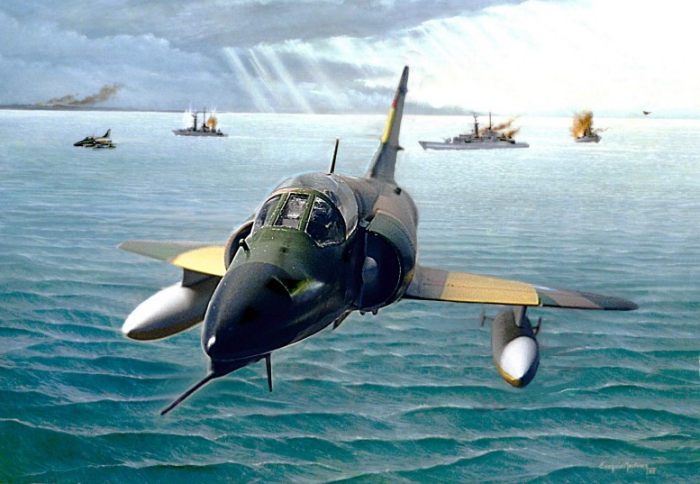 to say that this type of ship was no stranger to these men, as
the Argentine Navy had 2 in service at the time of the conflict (Santísima
Trinidad and Hércules) and Dimeglio had not only practiced against them before
the arrival of the Task Force, but had indeed been abroad one of them. Other
witnesses from the ground are Lt. Jorge Reyes and Major Hugo A. Maiorano, in
charge of the AA guns of BAM Malvinas and officers of the Navy like Lt. Rodolfo
Cionchi who saw the attack from Sapper Hill). There is also the testimony of
Capt. Pablo Carbalo who was flying in his A-4B south of the islands and after
having attacked by mistake an Argentine cargo decided to return to his base in
the mainland taking the northern route. Close to Puerto Argentino/Stanley he
found a ship covered in smoke. This made him change his mind and he returned
using the ingress route. Though the darkness that was falling didn’t allow him
to take a good look of this ship, it cannot be denied that it was the same D-42
that had retreated from the waters in front of Puerto Argentino. It is also
certain that the smoke for the turbines of the ships running at full steam can
be mistaken with a ship on fire…
to say that this type of ship was no stranger to these men, as
the Argentine Navy had 2 in service at the time of the conflict (Santísima
Trinidad and Hércules) and Dimeglio had not only practiced against them before
the arrival of the Task Force, but had indeed been abroad one of them. Other
witnesses from the ground are Lt. Jorge Reyes and Major Hugo A. Maiorano, in
charge of the AA guns of BAM Malvinas and officers of the Navy like Lt. Rodolfo
Cionchi who saw the attack from Sapper Hill). There is also the testimony of
Capt. Pablo Carbalo who was flying in his A-4B south of the islands and after
having attacked by mistake an Argentine cargo decided to return to his base in
the mainland taking the northern route. Close to Puerto Argentino/Stanley he
found a ship covered in smoke. This made him change his mind and he returned
using the ingress route. Though the darkness that was falling didn’t allow him
to take a good look of this ship, it cannot be denied that it was the same D-42
that had retreated from the waters in front of Puerto Argentino. It is also
certain that the smoke for the turbines of the ships running at full steam can
be mistaken with a ship on fire…
In the meantime and while climbing thru 20,000 ft and still above the islands TORNO who were warned by the CIC at Puerto Argentino/Stanley that another British CAP was following them (the second one of the day). TORNO 3 didn’t hear the warning nor his leader telling his men to eject the ventral tank and dive under the clouds below. As a consequence Aguirre Faget kept on flying steadily with his 3 drop tanks on trying to maximize his fuel consumption while his 2 companions dove fast and hid under the clouds beneath…to find that they had been very lucky: the had ended up in a valley with hills higher on their sides! Still supersonic and now at very low height Dimeglio decided that they were using too much fuel and thus they both climbed again when they reached San Carlos Waters. Their flying altitudes now were: TORNO 1 at 42,000 ft, TORNO 2 at 21,000 ft and TORNO 3 at 30,000 ft.
The Argentine CIC kept a running commentary about the approaching SHARS on Aguirre Faget but he was still unable to receive and understand that he was in grave danger. Eventually, the CIC decided to send another Dagger section that were orbiting as a CAP (FORTIN with Capt Donadille and 1st Lt. Senn) in persecution of the pair of Harriers that was threatening TORNO 2. They ejected their external tanks and accelerated to 1.4 Mach.
The CIC gave them a vector to reduce the distance as fast as possible while feeding them with the distance between TORNO 2 and the British CAP and the one separating FORTIN from the SHARs. Flying supersonic the Daggers starting to catch up the Harriers faster than these were approaching TORNO 2. The problem they faced is that the interception course was 320 degrees and this was putting the sun straight ahead. The Shafrir were locked on the sun, the Daggers had no radar on board and Donadille and Senn were running the risk of overtaking the Harriers…thus becoming the hunted. Effectively the only armament the Daggers had were the 30 mm guns on Senn’s plane.
At the moment that the distance between the SHARS and FORTIN was 1.5 miles and it seemed that a dramatic end could take place the British pilots, clearly alerted by their own controller, made a Split S and left the persecution of TORNO 2. It was the end of a 150 km long pursuit for FORTIN flight.
As they did not have modern navigational equipment, all that the Dagger pilots could do to get back home was point their noses in the direction of the continent (the setting sun) and estimate their distance to their base by the time they had been in the air. Dropping their remaining external tanks to reduce drag allowed them to reach BAM San Julian with just enough “juice” to land.
Upon landing the 5 pilots embraced each other. They had successfully carried out the first air to sea attack in the history of the Argentine Air Force. As Capt. Donadille stated later on...he had chased the Harriers away armed only with a bladeless knife (“el mango del cuchillo”) as his guns were not working and his missiles were locked on the sun. The happiness of their accomplishment was somehow dimmed with the loss of García Cuerva and Ardiles.
The attack had also proven wrong the Argentine Navy’s assessment that claimed
that the RN warships
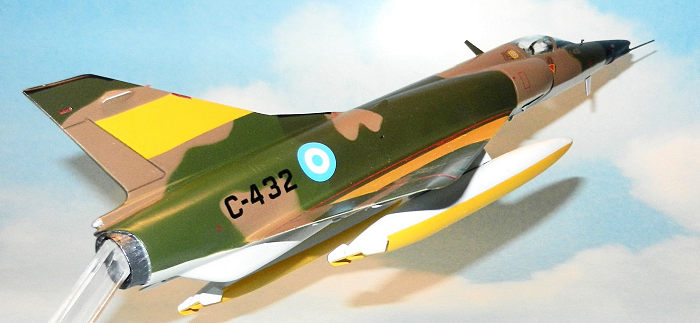 were so powerful that less than half of any attacking force
had a chance of coming back. Spirits in the Air Force pilots rose as a
consequence of this attack. They now realized that they had a good chance of
getting away unharmed after attacking the Task Force. Not everything seemed to
be so gloomy now.
were so powerful that less than half of any attacking force
had a chance of coming back. Spirits in the Air Force pilots rose as a
consequence of this attack. They now realized that they had a good chance of
getting away unharmed after attacking the Task Force. Not everything seemed to
be so gloomy now.
C-432 flew several other missions during the war for a grand total of 8 sorties which makes her one of the most flown Daggers during the war. The most notable missions were on
June 4th: PINA squadron successfully dive bombed British positions around Mount Kent. Each planes was armed with 4 x 250 parachute dragged bombs. C-432 was flown by Vicecomodoro Villar, leader of “La Marinette”. Capt. Demierre and 1st Lieutenants Roman and Musso. They flew under radar control at 43,000 ft and when close to the target the 4 Daggers formed a line with each plane aprox 1,000 mt away from each other. At the exact moment they were ordered to dive. They had no visual with the target as it was covered in clouds. Gathering speed at their 30 degree angle dive they dropped the bombs from 20,000 ft inside the clouds and then climbed again to a safe altitude. The following day a follow up mission with a different attack profile failed to achieve success as bad weather prevented them from locating their targets.
June 8th: Vicecomodoro Villar led CARTA section whose mission was to try to lure SHAR CAPS during the attacks on Bahia Agradable/Bluff Cove. The three planes were only armed with their 30 mm guns and no missiles. Lt. Callejo was flying C-432. Ingressing from the northwest at high altitude they succeeded in drawing the attention of HMS Cardiff who ordered the SHAR CAP flown by Cdr. Ward and Lt. Thomas to engage them. Dropping their search for Lt. Sanchez, the sole survivor of the A4-B Skyhawks that sunk Foxtrot 4 and had been mauled by another CAP (Morgan/Smith), Ward’s CAP climbed in pursuit of the Daggers. Once the Argentine CIC informed CARTA that the Harriers were after them and Villar planes turned tailed, “led” the Harriers away from Sanchez and accomplished the objective of their mission.
June 13th: tasked with bombing British positions at Mount Longdon GAUCHO section was flown by the same pilots that had successfully carried out the 1st attack on the Task Force on May 1st. C-432 was flown by Capt. Dimeglio an his wingman was Lt. Roman in C-421 (Aguirre Faget’s C-412 could not take part as a failure in the brakes system was detecting just before taking off). The planes configuration was the same also as on May 1 (2 x 250 kg bombs). On their way to the target from the southwest they found Sea Lynx XZ233 from HMS Cardiff. Assuming that they were going to be reported by the helo they decided to attack it with their guns. They missed their unsuspecting target on their first run that now, alerted by the noise of the Atar reactors and the sight of the turning Daggers started very effective maneuvers and finally the Dagger pilots left the Sea Lynx alone returning to their base in the continent because the surprise factor had been lost.
C-432 survived the war, was converted to Finger standard around 1988 and was retired along the other Mirage IIIEA/Fingers (ex Daggers) late 2015.
| THE KIT |
This is a 1/50th scale plane and it depicts a Recco (Mirage IIIR) version. It
is molded in dark silver plastic and the general shape is correct except for the
fact that I believe that the proportions are
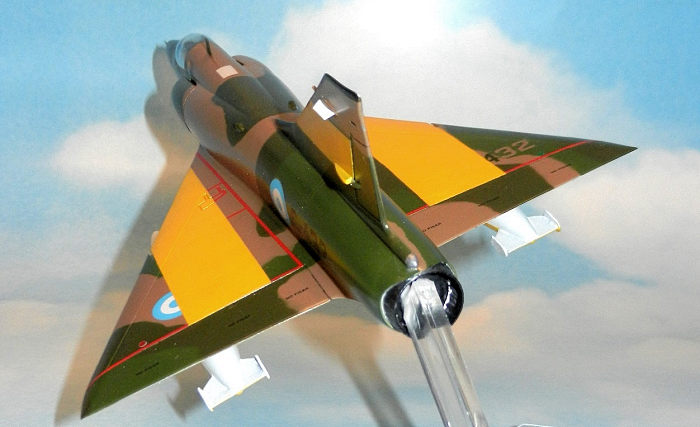 wrong: from the nose to the tail
the fuselage seems to be in 1/48th scale but from that point backwards the plane
is 1/50th. This is based on superimposing the fuselage sides of the Italeri and
the Fujimi kits. Also then the tail is smaller (probably around 3 to 5 mm). But
the area where the scale issue is more evident is on the wings. The wingspan is
approximately 10 mm too narrow and the length is another 7 mm or so too short.
wrong: from the nose to the tail
the fuselage seems to be in 1/48th scale but from that point backwards the plane
is 1/50th. This is based on superimposing the fuselage sides of the Italeri and
the Fujimi kits. Also then the tail is smaller (probably around 3 to 5 mm). But
the area where the scale issue is more evident is on the wings. The wingspan is
approximately 10 mm too narrow and the length is another 7 mm or so too short.
The nose has the openings for the cameras…but no clear parts to cover them. The landing gear is rachitic and the nose doors seems to be in the wrong place. There are no decent wheel wells and several scoops are missing…most notably the vents under engine air intakes. There are two 1,300 lt tanks and nothing else.
| CONSTRUCTION |
I built this kit almost 20 years ago and converted it to a Dagger. With my by then limited knowledge and resources it seemed to be decent but for you to have an idea I had no knowledge about the use of a glossy varnish (so all decals were showing the clear areas), no use of putty whatsoever, and the nose was transformed into a M5 one by using a bomb tip from the spares and with all the other windows being covered using…playdough! When we moved to Canada the plane suffered during the transportation and was relegated to a practice kit to test new techniques. It spent many years inside a box and was pulled out just to try something I had just learnt.
When late last year I decided to see what I could do with it and seeing some merit in (as much as the Fujimi scale issue would allow me) rebuild it properly I sunk all the parts in bleach for several days. The paint and decals came off with no problem and the process to turn it into a decent Dagger started.
First I decided to forget the awful landing gear. The idea worked great because closing the doors would also cover the non-existent wheel wells. I did not do much in the cockpit area (canopy is a single piece with the windshield so it was going to be left closed) except for improving the painting of the pilot including the Grupo 6 badges on the helmet. I had decided to make C-432 again (as I had done in Argentina) so the pilot would be Dimeglio. The detailed I missed is that the three TORNO pilots worn their jackets inside out with the bright orange showing…
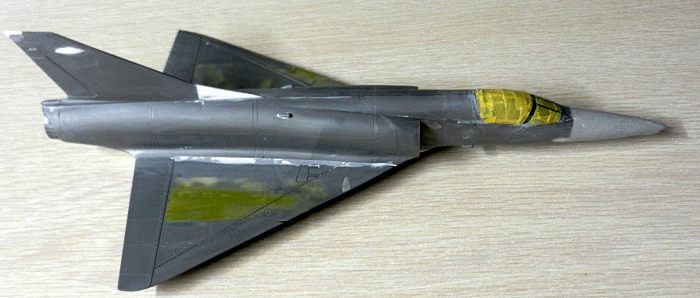 Using the Italeri kit as a reference I moved the nose landing gear doors
position. Somehow the opening in the original kit seemed to be too long so I had
to cover the back of the opening with plastic and putty. I added some internal
support to get the doors firmly attached on place. The main landing gear ones
were much easier but clearly undersized when compared to Italeri.
Using the Italeri kit as a reference I moved the nose landing gear doors
position. Somehow the opening in the original kit seemed to be too long so I had
to cover the back of the opening with plastic and putty. I added some internal
support to get the doors firmly attached on place. The main landing gear ones
were much easier but clearly undersized when compared to Italeri.
The extension to the vertical tail surface was re created using plasticard (I had used tin foil 20 years ago…). The vents under the main air intakes were scratchbuilt. The ventral fin supplied by Fujimi is not good for a Dagger as it was replaced by an fuel tank. I made a copy in resin that because of the fuselage dimensions issues in that area I had to shorten.
Using a Nesher/Dagger resin nose as a template I made several molds using
Plaster of Paris. Once the halves had dried out (I made 3 for each side of the
nose) I took two part epoxy glue (the one that comes in with two “syringes” that
are deliver their content by pressing on a single trigger) and deployed the
thoroughly mixed paste inside the molds. As it is quite soft and runny it filled
all the panels and contour very well. The following day I broke the Plaster of
Paris and freed the 6 halves. C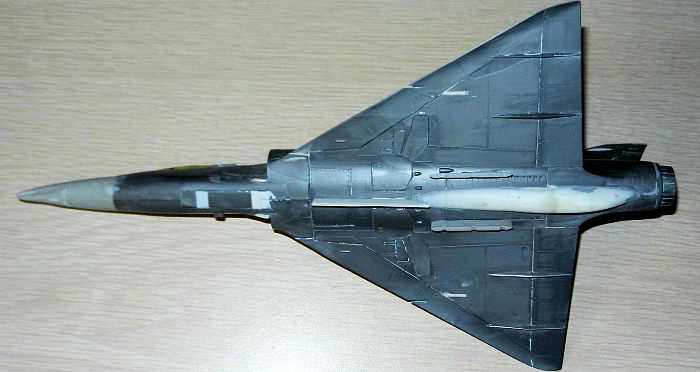 learly there was some excess of epoxy here and
there that had to be cut out. Sanding the mating surfaces carefully I then was
able to deliver 3 new noses. This is a cheap system that requires a little bit
of extra work. I picked one of the pairs and using more 2 part epoxy glue I
joined them together. Once dried I wet sanded the overflowing glue, rounded the
surfaces and set the nose aside. The IFF system on the tail is placed on top of
some oval supports. I cut these shapes from plastic and used Putty to improve
the union sanding the edges improving the curvature. The new nose was added and
the union was improved using some putty and sandpaper.
learly there was some excess of epoxy here and
there that had to be cut out. Sanding the mating surfaces carefully I then was
able to deliver 3 new noses. This is a cheap system that requires a little bit
of extra work. I picked one of the pairs and using more 2 part epoxy glue I
joined them together. Once dried I wet sanded the overflowing glue, rounded the
surfaces and set the nose aside. The IFF system on the tail is placed on top of
some oval supports. I cut these shapes from plastic and used Putty to improve
the union sanding the edges improving the curvature. The new nose was added and
the union was improved using some putty and sandpaper.
My idea was to represent Dimeglio’s plane coming out of the attack on May 1st to I only needed two drop tanks. The ventral station for the tank was copied in resin. The bomb racks were modified using some taken from the spares box (from a Hobbycraft A4 Skyhawk). The air intakes were given a coat of white paint and glued together leaving them aside for the final stages of the project.
The VHF and IFF antennas were cut from strips of Evergreen. I made them slightly longer to bury them in blue tac to paint them. They were painted in tan (top VHF), light grey (bottom VHF) and white (IFF). Once dry the part that was buried in blue tac was cut out delivering the proper length for these parts.
The gunsight was added and the windshield/canopy were glued in place. The union of this part does not follow the actual canopy and the clear part has actually part of the frame of the canopy! So I was forced to sand and hide this union with Putty. After masking the windshield and canopy the plane was ready for the paint job.
| COLORS & MARKINGS |
I used ModelMaster Acrylic paints. First I used Light grey (4766) for all the undersurfaces, followed by Tan (4709), then Medium Green (4734) and finally Dark Green (4726). The demarcation lines between colours are not sharp so I used Blue Tac to obtain the desired effect.
The yellow (4683) ID bands were painted on wings and tail. The 30 mm guns
openings were painted with black as the front of several air intakes around the
plane. The nose was masked and painted black like the internal surface of the
windshield and canopy frames (these last where then painted with the cammo
colours). The drop tanks were painted in white (top) and yellow (bottom).
Moveable surfaces of t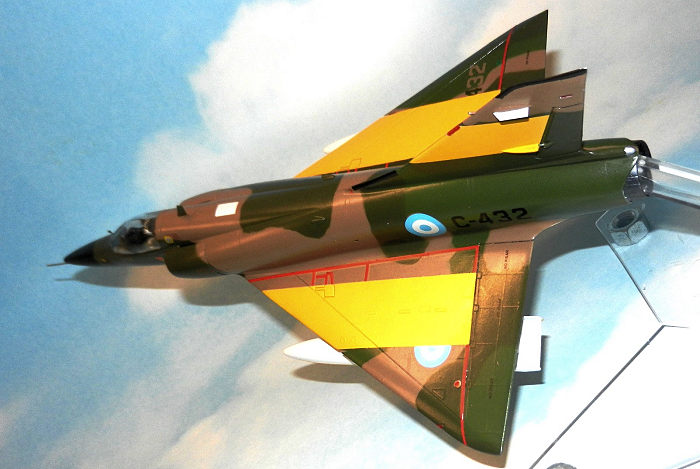 he plane were highlighted using a 4B pencil.
he plane were highlighted using a 4B pencil.
Future gave a gloss surface for the decals: a mix of self made stencils (printed on clear decal paper) and AeroCalcas for the tail numbers with the red lines on the wings coming from the spares box. Once painted, the air intakes were added. Finally, a coat of semi gloss clear varnish from AeroMaster sealed the decals.
The most important part was now to attach the plane to a stand. I had scratchbuilt a clear stand using a pictures frame support and clear Plexiglas. I drilled a hole on the “arm” of the stand and another one on the exhaust pipe. Thru these I put a nail and glued everything using a combination of Crazy Glue and 2 part epoxy glue. Then I tested the stand and found that the plane was too heavy and it was falling on the nose. I had to make the base of the stand heavier to compensate for the weight of the kit. I added several nuts to the base until it was able to hold the plane in place.
All the position lights were painted first with light grey, followed by aluminum and then ModelMaster clear green or red.The sequence to add all other parts started from the center moving outwards: ventral tank support, bomb racks, wing drop tanks. Then I moved to the top portion of the plane where I installed the VHF and IFF antennas, the little antenna in front of the tail. The model was finished when I scratchbuilt the prominent pitot tube on the nose.
| CONCLUSIONS |
When placed along with the other Daggers on the flight line the dimensions issues are not that evident due to the “in flight and turning” attitude of the kit. It is not one of my most accurate kits due to the scale but it represents very well the plane flown by “Joker” Dimeglio during the historic May 1, 1982 the day of the Baptism of Fire of the Argentine Air Force.
With thanks like always to Exequiel Martinez for his help to illustrate this article, using my plane over his original painting on this epic day.
| REFERENCES |
Dagger & Finger, Núñez Padín
Dios y los Halcones, Pablo Carballo
Halcones sobre Malvinas, Pablo Carballo
La Guerra Inaudita, Rubén Moro
La Batalla Aérea de nuestras Islas Malvinas, Pío Matassi
Aeroespacio issue #534
Ellos también combatieron, Guillermo Posadas
La Fuerza Aérea en Malvinas, Tomo I
The Falklands War, Duncan Anderson
Harrier over the Falklands, Nigel Ward
Guerra Aérea en las Malvinas, Benigno Andrada
Personal interviews with Donadille, Piuma, Senn and Aguirre Faget
| FINAL CONSTRUCTION |
15 December 2017
Copyright ModelingMadness.com. All rights reserved.
Thanks to
for the review kit. You can find this kit at your favorite hobby shop or on-line
retailer. If you would like your product reviewed fairly and
fairly quickly, please
contact
the editor or see other details in the
Note to
Contributors. Back to the Main Page
Back to the Review
Index Page
Back to the Previews Index Page